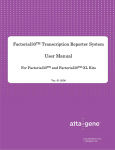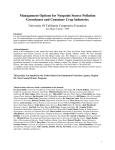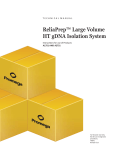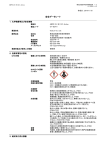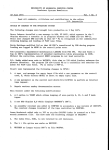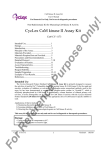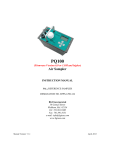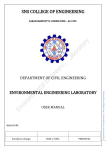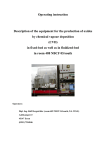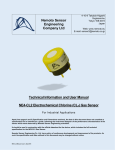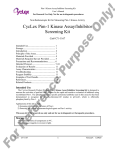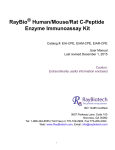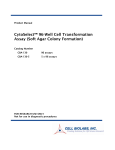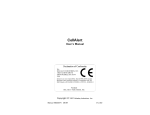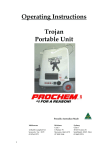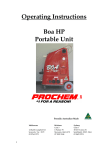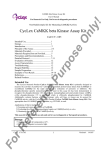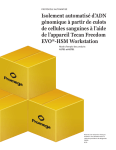Download For Reference Purpose Only!
Transcript
ly ! AMPK Kinase Assay Kit User’s Manual For Research Use Only, Not for use in diagnostic procedures On Non-Radioisotopic Kit for Measuring AMPK Kinase Activity CycLex AMPK Kinase Assay Kit en ce Pu rp Intended Use................................................ 1 Storage......................................................... 1 Introduction ................................................. 2 Principle of the Assay.................................. 3 Materials Provided ...................................... 4 Materials Required but not Provided .......... 4 Precautions and Recommendations............. 5 Detailed Protocol.......................................... 6-12 Evaluation of Results ................................... 13 Assay Characteristics ...................................13 Troubleshooting ........................................... 13 Reagent Stability .......................................... 13 Sample Preparation.......................................14-16 Example of Test Results................................ 17-21 References......................................................22 Related Product..............................................23 os e Cat# CY-1182 Intended Use er The CycLex Research CycLex AMPK Kinase Assay Kit is primarily designed to measure the activities of purified AMP-activated protein kinase (AMPK) or recombinant AMPK for the rapid and sensitive evaluation of activators or inhibitors. The phospho-serine specific monoclonal antibody used in this assay kit has been demonstrated to recognize the phospho-serine 789 in mouse Insulin Receptor Substrate-1 (IRS-1), which is efficiently phosphorylated by AMPK. Additionally, column fractions of cultured primary cell, cell line, or tissue can be assayed for AMPK activity with the CycLex Research Product CycLex AMPK Kinase Assay Kit if the appropriate dose of AMPK specific inhibitor e.g. Compound C is used. ef Applications of this kit include: 1) Screening activators or inhibitors of AMPK. 2) Evaluating the effects of pharmacological agents on AMPK activity in vitro. 3) Monitoring the purification of AMPK activity. Storage rR • Upon receipt store all components at 4°C. • Don’t expose reagents to excessive light. Fo Cat#: CY-1182 1 Version#: 120420 On Introduction ly ! AMPK Kinase Assay Kit User’s Manual For Research Use Only, Not for use in diagnostic procedures Measurement of AMPK activity Pu rp os e AMP-activated protein kinase (AMPK) regulates cellular energy metabolism by phosphorylation of key enzymes in metabolic pathways, such as acetyl–coenzyme A carboxylase (ACC) (1) or mTOR (mammalian target of rapamycin) (2), by modulating their activities, and by regulating the activity of transcription factors (3) and transcriptional cofactors (4). Its functions have been extensively studied in muscles and liver. AMPK stimulates pathways, which increase energy production (glucose transport, fatty acid oxidation) and switches off pathways, which consume energy (lipogenesis, protein synthesis, gluconeogenesis). Activation of AMPK in adipose tissue can be achieved through situations such as fasting and exercise. Adiponectin and leptin as well as hypoglycaemic drugs are activators of adipose tissue AMPK. This activation probably involves changes in the AMP/ATP ratio, and the upstream kinase LKB1 (5). These results have led to the concept that AMPK has an interesting pharmaceutical potential in situations of insulin resistance (type 2 diabetes) and it is indeed the target of existing drugs, e.g. Metformin and hormones which improve insulin sensitivity. Mammalian AMPK is a trimeric enzyme comprising a catalytic α subunit (63 kDa) and non-catalytic β and γ subunits (6, 7). Multiple isoforms of each mammalian enzyme exist (α1, α2, β1, β2, γ1, γ2, γ3), each encoded by a different gene. The β subunits have a calculated molecular mass of 30 kDa, but migrate on SDS-PAGE with apparent masses of 38 kDa (β1) and 34 kDa (β2), whereas the three γ isoforms have molecular masses of 37 kDa (γ1), 63 kDa (γ2) and 55 kDa (γ3) (8). While AMPK complexes containing α2 (the first catalytic isoform to be cloned) (9) predominate in skeletal and cardiac muscle (10), approximately equal levels of α1 and α2 complexes are present in the liver (11). In contrast, pancreatic islet β-cells largely express α1 complex activity (12, 13). rR ef er en ce The protocol generally regarded as most sensitive for the quantitative measurement of AMPK activity involves incubation of the AMPK sample with substrate, either a natural or synthetic polypeptide (such as SAMS peptide), in the presence of Mg2+and 32P-labeled ATP. The reaction is terminated by "spotting" a sample onto a phosphocellulose P81 filter paper disc, followed by washing extensively to remove unincorporated radiolabel and the incorporated radioactivity on P81 filter is counted. While sensitive, this method is labor-intensive, generates hazardous radioactive waste and depends on a radioisotope of short half-life. It is particularly unsuitable when kinase assays are only performed on an infrequent basis. The CycLex AMPK Kinase Assay Kit uses anti-phospho-mouse IRS-1 S789 monoclonal antibody (AS-4C4) and peroxidase coupled anti-mouse IgG antibody as a reporter molecule in a 96-well ELISA format. This assay provides a non-isotopic, sensitive and specific method to measure the activities of AMPK Fo Cat#: CY-1182 2 Version#: 120420 On Principle of the Assay ly ! AMPK Kinase Assay Kit User’s Manual For Research Use Only, Not for use in diagnostic procedures rp os e The CycLex Research Products CycLex AMPK Kinase Assay Kit is a single-site, semi-quantitative immunoassay for AMPK activity. Plates are pre-coated with a substrate-peptide corresponding to surrounding mouse IRS-1 S789, which contains serine residue that can be efficiently phosphorylated by AMPK. The detector antibody specifically detects only the phosphorylated form of serine residue on substrate-peptide. The CycLex AMPK Kinase Assay Kit may be used to study the kinetics of a purified AMPK as well as to screening AMPK activator or inhibitor. To perform the test, the sample is diluted in Kinase Buffer, pipetted into the wells and allowed to phosphorylate the bound substrate following the addition of Mg2+ and ATP. The amount of phosphorylated substrate is measured by binding it with a AS-4C4, an anti-phospho-mouse IRS-1 S789 monoclonal antibody, followed by binding with horseradish peroxidase conjugated anti-mouse IgG, which then catalyzes the conversion of the chromogenic substrate tetra-methylbenzidine (TMB) from a colorless solution to a blue solution (or yellow after the addition of stopping reagent). The color is quantitated by spectrophotometry and reflects the relative amount of AMPK activity in the sample. For kinetic analysis, the AMPK-containing sample is added to the wells in a similar fashion and at varying times the reaction is stopped by the addition of the chelator, sodium ethylenediaminetetraacetate (EDTA) and the amount of phosphorylated substrate determined as before. Pu Summary of Procedure Add 100 µL of sample to the wells Incubate for 30 min at 30°C. en ce Wash the wells Add 100 µL of Anti-Phospho-mouse IRS-1 S789 monoclonal Antibody. Incubate for 30 min at room temp. Wash the wells Add 100 µL of HRP conjugated anti-mouse IgG Incubate for 30 min at room temp. er Wash the wells ef Add 100 µL of Substrate Reagent rR Add 100 µL of Stop Solution Fo Cat#: CY-1182 Measure absorbance at 450 nm 3 Version#: 120420 On Materials Provided ly ! AMPK Kinase Assay Kit User’s Manual For Research Use Only, Not for use in diagnostic procedures All samples and standards should be assayed in duplicate. The following components are supplied and are sufficient for the one 96-well microtiter plate kit. os e Microplate: One microplate supplied ready to use, with 96 wells (12 strips of 8-wells) in a foil, zip-lock bag with a desiccant pack. Wells are coated with mouse IRS-1 S789 -peptide as AMPK substrate. 10X Wash Buffer: One bottle containing 100 mL of 10X buffer containing 2 %Tween®-20 Kinase Buffer: One bottle containing 20 mL of 1X buffer; used for Kinase Reaction Buffer and sample dilution. rp 20X ATP: Lyophilized ATP Na2 salt. Reconstitute contents of vial with 1.6 mL of ddH2O. (See section “Preparation of Working Solution” page 6.) Anti-Phospho-mouse IRS-1 S789 Monoclonal Antibody (AS-4C4): One vial containing 12 mL of anti-phospho-mouse IRS-1 S789 monoclonal antibody AS-4C4). Ready to use. Pu HRP conjugated Anti-mouse IgG: One vial containing 12 mL of HRP (horseradish peroxidase) conjugated anti-mouse IgG. Ready to use. Substrate Reagent: One bottle containing 20 mL of the chromogenic substrate, tetra-methylbenzidine (TMB). Ready to use. en ce Stop Solution: One bottle containing 20 mL of 1 N H2SO4. Ready to use. Materials Required but not Provided rR ef er • AMPK Active enzyme(s): Available from CycLex Co., Ltd. (See page 6, section “ Preparation of Working Solution” and page 24, section “Related Product”). e.g. The AMPK (α1/β1/γ1), Active (Cat# CY-SEA11) • 10X AMP (100 µM soln): AMP (Adenosine 5-monophosphate sodium salt) is available from Sigma, Cat#. A1752. • 10X Compound C (250 µM): Compound C is available from Sigma, Cat#. P5499. 2.5 mM stock solution (DMSO) diluted 1:10 in Kinase Buffer. • Pipettors: 2-20 µL, 20-200 µL and 200-1000 µL precision pipettors with disposable tips. • Precision repeating pipettor • Wash bottle or multichannel dispenser for plate washing. • Microcentrifuge and tubes for sample preparation. • Vortex mixer • Plate reader capable of measuring absorbance in 96-well plates at dual wavelengths of 450 nm/540 nm. Dual wavelengths of 450/550 or 450/595 nm can also be used. The plate can also be read at a single wavelength of 450 nm, which will give a somewhat higher reading. • 500 or 1000 mL graduated cylinder • Reagent reservoirs • Deionized water of the highest quality • Disposable paper towels Fo Cat#: CY-1182 4 Version#: 120420 ly ! Precautions and Recommendations On AMPK Kinase Assay Kit User’s Manual For Research Use Only, Not for use in diagnostic procedures • Store the ATP at -20°C when not in use. Store all other components at 4°C. Do not expose reagents to excessive light. Avoid freeze/thaw cycles. • Allow all the components to come to room temperature before use. os e • All microplate strips that are not immediately required should be returned to the zip-lock pouch, which must be carefully resealed to avoid moisture absorption. • Do not use kit components beyond the indicated kit expiration date. • Use only the microtiter wells provided with the kit. rp • Rinse all detergent residue from glassware. • Use deionized water of the highest quality. Pu • Do not mix reagents from different kits. • The buffers and reagents used in this kit contain either sodium Kathon-CG as preservatives. Care should be taken to avoid direct contact with these reagents. • Do not mouth pipette or ingest any of the reagents. en ce • Do not smoke, eat, or drink when performing the assay or in areas where samples or reagents are handled. • Dispose of tetra-methylbenzidine (TMB) containing solutions in compliance with local regulations. • Avoid contact with Substrate Solution which contains hydrogen peroxide. • Avoid contact with Stop Solution which contains Sulfuric Acid. er • In case of contact with the Stop Solution and the Substrate Solution, wash skin thoroughly with water and seek medical attention, when necessary. • Biological samples may be contaminated with infectious agents. Do not ingest, expose to open wounds or breathe aerosols. Wear protective gloves and dispose of biological samples properly. rR ef • CAUTION: Sulfuric Acid is a strong acid. Wear disposable gloves and eye protection when handling Stop Solution. Fo Cat#: CY-1182 5 Version#: 120420 On Detailed Protocol ly ! AMPK Kinase Assay Kit User’s Manual For Research Use Only, Not for use in diagnostic procedures os e The CycLex AMPK Kinase Assay Kit is provided with removable strips of wells so the assay can be carried out on separate occasions using only the number of strips required for the particular determination. Since conditions may vary, running an aliquot of the appropriate AMPK Active enzyme (See page 24, section “ Related Product”), separately available from CycLex, should be included in each assay. Disposable pipette tips and reagent troughs should be used for all transfers to avoid cross-contamination of reagents or samples. Preparation of Working Solution 1. Prepare a working solution of Wash Buffer by adding 100 mL of the 10X Wash Buffer (provided) to 900 mL of ddH2O. Mix well. Store at 4°C for two weeks or -20°C for long-term storage. rp 2. Prepare 20X ATP Solution by adding 1.6 mL of ddH2O to the vial of 20X ATP (provided, lyophilized). Mix gently until dissolved. The final concentration of the 20X ATP Solution should be 1.25 mM. Store the solution in small aliquots (e.g. 100 µL) at -20°C. Kinase Buffer (provided) 20X ATP (provided) 96 assays 10 assays 9.95 mL 0.05 mL 995 µL 5 µL 199 µL 1 µL 10 mL 1,000 µL 200 µL en ce Total Pu 3. Prepare Kinase Reaction Buffer (5 µM ATP plus) by mixing following reagents for activator screening. 2 assay You will need 80-90 µL of Kinase Reaction Buffer (5 µM ATP plus) per assay well. Mix well. Discard any unused Kinase Reaction Buffer (ATP plus) after use. 4. Prepare Kinase Reaction Buffer (50 µM ATP plus) by mixing following reagents for inhibitor screening and Standard Assay. 10 assays 1 assay Kinase Buffer (provided) 20X ATP (provided) 9.5 mL 0.5 mL 950 µL 50 µL 95 µL 5 µL Total 10 mL 1000 µL 100 µL er 96 assays rR ef You will need 80-90 µL of Kinase Reaction Buffer (50 µM ATP plus) per assay well. Mix well. Discard any unused Kinase Reaction Buffer (ATP plus) after use. Fo Cat#: CY-1182 6 Version#: 120420 ly ! AMPK Kinase Assay Kit User’s Manual For Research Use Only, Not for use in diagnostic procedures os e On 5. Prepare AMPK Active enzyme as a Positive Control for phosphorylation. Add a Positive Control to the first well in each assay. e.g. 0.05-0.20 ng / 10 µL of the AMPK (α1/β1/γ1), Active (CycLex Co., Ltd., See page 24, section “Related Product”). Use BSA-containing buffer to dilute the enzyme for the stability of enzyme activity. Dilution Buffer (as an example, not provided): 20mM Hepes-KOH (pH 7.5), 1% BSA, 1mM EDTA, 2mM DTT, 50mM NaCl and 50% glycerol Dilution: 1st Step: Dilute the enzyme 1:100 with the Dilution Buffer. 2nd Step: Dilute 1st Step enzyme 1: 50-200 with Kinase Buffer (provided). Standard Assay rp 1. Remove the appropriate number of microtiter wells from the foil pouch and place them into the well holder. Return any unused wells to the foil pouch, refold, seal with tape and store at 4°C. 2. Prepare all samples (diluted with Kinase Buffer as needed). All samples should be assayed in duplicate. Pu 3. To assay partially purified recombinant AMPK, add 10 µL of each fraction to the wells of the assay plate on ice. AMPK Active enzyme should be included in duplicate wells in each assay as a positive control for phosphorylation, e.g. 0.1 ng/10 µL of AMPK (α1/β1/γ1), Active (Cat# CY-SEA11) (See page 6, section “ Preparation of Working Solution” and page 24, section “Related Product”). en ce 4. Begin the kinase reaction by addition of 90 µL Kinase Reaction buffer (50 µM ATP plus) per well, cover with plate sealer, and incubate at 30°C for 30 minutes. 5. Wash wells five times with Wash Buffer making sure each well is filled completely. Remove residual Wash Buffer by gentle tapping or aspiration. 6. Pipette 100 µL of Anti-Phospho-mouse IRS-1 S789 Monoclonal Antibody (AS-4C4) into each well, cover with plate sealer or lid, and incubate at room temperature (ca.25°C) for 30 minutes. 7. Wash wells five times as same as in step 5. er 8. Pipette 100 µL of HRP-conjugated Anti-mouse IgG into each well, cover with plate sealer or lid, and incubate at room temperature (ca.25°C) for 30 minutes. Discard any unused conjugate after use. ef 9. Wash wells five times as same as in step 5. 10. Add 100 µL of Substrate Reagent to each well and incubate at room temperature (ca.25°C) for 5–15 minutes. rR 11. Add 100 µL of Stop Solution to each well in the same order as the previously added Substrate Reagent. 12. Measure absorbance in each well using a spectrophotometric plate reader at dual wavelengths of 450/540 nm. Dual wavelengths of 450/550 or 450/595 nm can also be used. Read the plate at 450 Fo Cat#: CY-1182 7 Version#: 120420 ly ! AMPK Kinase Assay Kit User’s Manual For Research Use Only, Not for use in diagnostic procedures On nm if only a single wavelength can be used. Wells must be read within 30 minutes of adding the Stop Solution. Note-1: Complete removal of liquid at each step is essential to good performance. After the last wash, remove any remaining Wash Buffer by aspirating or decanting. Invert the plate and blot it against clean paper towels. os e Note-2: Reliable signals are obtained when either O.D. values do not exceed 0.25 units for the blank (no enzyme control), or 2.5 units for a positive control when using the 0.1 ng of AMPK (α1/B1/G1), Active (Cat# CY-SEA11) . rp Note-3: If the microplate reader is not capable of reading absorbance greater than the absorbance of the AMPK Active enzyme, perform a second reading at 405 nm. A new O.D. values, measured at 405 nm, is used to determine AMPK activity of off-scale samples. The readings at 405 nm should not replace the on-scale readings at 450 nm. Kinetic Assay Pu 1. Remove the appropriate number of microtiter wells from the foil pouch and place them into the well holder. Return any unused wells to the foil pouch, refold, seal with tape and store at 4°C. 2. Prepare all samples (diluted with Kinase Buffer as needed). All samples should be assayed in duplicate. en ce 3. To assay partially purified recombinant AMPK, add 10 µL of each fraction to the wells of the assay plate on ice. AMPK Active enzyme should be included in duplicate wells in each assay as a positive control for phosphorylation, e.g. 0.1 ng/10 µL of AMPK (α1/β1/γ1), Active (Cat# CY-SEA11) (See page 6, section “Preparation of Working Solution” and page 24, section “Related Product”). 4. Begin kinase reaction by addition of 90 µL Kinase Reaction Buffer (50 µM ATP plus) in duplicate per well in timed intervals (suggested interval is 4 minutes but should be individually determined for each system). After the final addition, incubate at 30°C for 20 minutes. er 5. Stop the reaction by flicking out the contents. (Alternatively, the reaction may be terminated by the addition of 150 µL 0.1 M Na EDTA, pH 8.0 to each well). 6. Wash wells five times with Wash Buffer making sure each well is filled completely. Remove residual Wash Buffer by gentle tapping or aspiration. ef 7. Pipette 100 µL of Anti-Phospho-mouse IRS-1 S789 Monoclonal Antibody (AS-4C4) into each well, cover with plate sealer or lid, and incubate at room temperature (ca.25°C) for 30 minutes. 8. Wash wells five times as same as in step 6. rR 9. Pipette 100 µL of HRP-conjugated Anti-mouse IgG into each well, cover with plate sealer or lid, and incubate at room temperature (ca.25°C) for 30 minutes. Discard any unused conjugate after use. 10. Wash wells five times as same as in step 6. Fo Cat#: CY-1182 8 Version#: 120420 ly ! AMPK Kinase Assay Kit User’s Manual For Research Use Only, Not for use in diagnostic procedures On 11. Add 100 µL of Substrate Reagent to each well (Avoid exposing the microtiter plate to direct sunlight Covering the plate with e.g. aluminum foil is recommended). Return Substrate A to 2-8°C immediately after the necessary volume is removed os e 12. Incubate the plate at room temperature (ca.25°C) for 5–15 minutes. (Appropriate incubation time may vary, and incubation time can be extended up to 20 minutes if the reaction temperature is below than 20°C). 13. Measure absorbance in each well using a spectrophotometric plate reader at dual wavelengths of 450/540 nm. Dual wavelengths of 450/550 or 450/595 nm can also be used. Read the plate at 450 nm if only a single wavelength can be used. Wells must be read within 30 minutes of adding the Stop Solution. Recommendations For activator screening Assay reagents Pu rp Special considerations when screening activators or inhibitors In order to estimate the activating or inhibitory effect on individual AMPK activity in the test chemicals correctly, it is necessary to conduct the control experiment of “Solvent control” at least once for every experiment and “Activator control” or Inhibitor control” at least once for the first experiment, in addition to “Test sample”, as indicated in the following table. When test chemicals cause an activating effect on AMPK activity, the level of A450 is strengthen as compared with “Solvent control”. Test sample For Activator 80 µL Solvent Control For Activator 80 µL Activator control 80 µL 10 µL - - Solvent for Activator - 10 µL - 10X AMP (100 µM) * - - 10 µL 10 µL 10 µL 10 µL en ce Kinase Reaction buffer (5 µM ATP) 10X Activator or equivalent AMPK Active enzyme ** or Purified enzyme sample er * Sigma (Cat# A1752): See page 4, section “Materials Required but not Provided” ** e.g. 0.005 ng/µL of AMPK (α1/β1/γ1), Active (CycLex Co., Ltd., Cat# CY-SEA11) : See page 6, section “Preparation of Working Solution” and page 24, section “Related Product” ef 1. Following the above table, add the Reagents to each well of the microplate. Finally, initiate reaction by adding 10 µL of “AMPK Active enzyme” to each well and mixing thoroughly at room temperature. Cover with plate sealer or lid, and incubate at 30°C for 30 minutes. rR 2. Follow the Standard Assay steps 5-12, page 7. Note: Although we suggest to conduct experiments as outlined in the table above, the optimal experimental conditions will vary depending on the parameters being investigated, and must be determined by the individual user. Especially, an appropriate amount of AMPK Active enzyme must be optimized by titration of the AMPK Active enzyme and setting the amount, which shows OD value does not exceed plateau range in dose response curve. Fo Cat#: CY-1182 9 Version#: 120420 On For inhibitor screening ly ! AMPK Kinase Assay Kit User’s Manual For Research Use Only, Not for use in diagnostic procedures Kinase Reaction buffer (50 µM ATP) 80 µL Solvent Control For Inhibitor 80 µL 10X Inhibitor or equivalent 10 µL - - 10 µL - - 10 µL 10 µL 10 µL Solvent for Inhibitor - 10X Compound C (250 µM) * - AMPK Active enzyme ** or Purified enzyme sample 80 µL rp 10 µL Inhibitor control os e Assay reagents Test sample For Inhibitor * Sigma (Cat# P5499): See page 4, section “Materials Required but not Provided” ** e.g. 0.01 ng/µL of AMPK (α1/β1/γ1), Active (CycLex Co., Ltd., Cat# CY-SEA11) : See page 6, section “Preparation of Working Solution” and page 24, section “Related Product” Pu 1. Following the above table, add the Reagents to each well of the microplate. Finally, initiate reaction by adding 10 µL of “AMPK Active enzyme” to each well and mixing thoroughly at room temperature. Cover with plate sealer or lid, and incubate at 30°C for 30 minutes. 2. Follow the Standard Assay steps 5-12, page 7. rR ef er en ce Note: Although we suggest to conduct experiments as outlined in the table above, the optimal experimental conditions will vary depending on the parameters being investigated, and must be determined by the individual user. Especially, an appropriate amount of AMPK Active enzyme must be optimized by titration of the AMPK Active enzyme and setting the amount, which shows OD value does not exceed plateau range in dose response curve. Fo Cat#: CY-1182 10 Version#: 120420 On Special considerations when measuring precise AMPK activity ly ! AMPK Kinase Assay Kit User’s Manual For Research Use Only, Not for use in diagnostic procedures In order to measure the activity of AMPK correctly, it is necessary to conduct the control experiment of “Inhibitor control” at least once for every experiment and “ATP minus control” at least once for the first experiment, in addition to “No enzyme control” as indicated in the following table. Although the level of A450 increases in “Test sample” when AMPK enzyme activity is in the sample, the high level of A450 is not observed in “Inhibitor control”, “ATP minus control” and “No enzyme control”. Inhibitor control 80 µL 80 µL Kinase Buffer (ATP minus) - - 10X Compound C (250 µM) * - 10 µL Vehicle for 10X Compound C 10 µL - Your enzyme sample AMPK Active enzyme ** Buffer for your enzyme sample 10 µL - 80 µL No enzyme control 80 µL 80 µL - - - - - 10 µL 10 µL 10 µL 10 µL - 10 µL - 10 µL rp 10 µL - Positive control Pu Kinase Reaction buffer (50 µM ATP) ATP minus control - os e Test Sample Assay reagents * Sigma (Cat# P5499): See page 4, section “Materials Required but not Provided” ** e.g. 0.01 ng/µL of AMPK (α1/β1/γ1), Active (CycLex Co., Ltd., Cat# CY-SEA11) : See page 6, section “Preparation of Working Solution” and page 24, section “Related Product” en ce 1. Following the above table, add the Reagents to each well of the microplate. Finally, initiate the reaction by adding 10 µL of “Your enzyme sample” or “Buffer” to each well and mixing thoroughly at room temperature. Cover with plate sealer or lid, and incubate at 30°C for 30 minutes. 2. Follow the Standard Assay steps 5-12, page 7. rR ef er Note: Although we suggest to conduct experiments as outlined in the table above, the optimal experimental conditions will vary depending on the parameters being investigated, and must be determined by the individual user. Especially, an appropriate amount of AMPK Active enzyme must be optimized by titration of the AMPK Active enzyme and setting the amount, which shows OD value does not exceed plateau range in dose response curve. Fo Cat#: CY-1182 11 Version#: 120420 ly ! AMPK Kinase Assay Kit User’s Manual For Research Use Only, Not for use in diagnostic procedures Assay reagents Kinase Reaction buffer (50 µM ATP) Test Sample 80 µL os e On Special considerations when measuring relative AMPK activity in cell lysate In order to measure the relative activity of AMPK in cell lysate, it is necessary to conduct the control experiment of “Inhibitor control” for every sample and “Positive control” at least once for the first experiment as indicated in the following table. Here “relative AMPK activity” is defined as Compound C sensitive protein kinase activity in cell lysate using this kit. Thus “relative AMPK activity” can be calculated by subtracting A450 of “Inhibitor control” from A450 of Test Sample”. Although the level of A450 increases in “Test sample” when AMPK enzyme activity is in the sample, the high level of A450 is not observed in “Inhibitor control”, usually less than 0.4. Inhibitor control 80 µL Positive control 80 µL - - 10 µL - - 10X Compound C (250 µM) * - Vehicle for 10X Compound C 10 µL - 10 µL Your enzyme sample AMPK Active enzyme*** Buffer 10 µL - 10 µL - 10 µL - Pu rp Kinase Buffer (ATP minus) * Sigma (Cat# P5499): See page 4, section “Materials Required but not Provided” ** e.g. 0.01 ng/µL of AMPK (α1/β1/γ1), Active (CycLex Co., Ltd., Cat# CY-SEA11) : See page 6, section “Preparation of Working Solution” and page 24, section “Related Product” en ce 1. Following the above table, add the Reagents to each well of the microplate. Finally, initiate the reaction by adding 10 µL of “Your cell lysate sample” or “AMPK Active enzyme” to each well and mixing thoroughly at room temperature. Cover with plate sealer or lid, and incubate at 30°C for 30 minutes. 2. Follow the Standard Assay steps 5-12, page 7. CAUTION: It should be noted that this assay kit detects not only AMPK activity but also other protein kinases, e.g. Salt-inducible kinase-2, in crude extract and column sample. You should trace AMPK protein level by western blotting in column fractions. rR ef er Note: Although we suggest to conduct experiments as outlined in the table above, the optimal experimental conditions will vary depending on the parameters being investigated, and must be determined by the individual user. Especially, an appropriate amount of AMPK Active enzyme must be optimized by titration of the AMPK Active enzyme and setting the amount, which shows OD value does not exceed plateau range in dose response curve. Fo Cat#: CY-1182 12 Version#: 120420 On Evaluation of Results ly ! AMPK Kinase Assay Kit User’s Manual For Research Use Only, Not for use in diagnostic procedures os e 1. Average the absorbance values for the AMPK sample duplicates (positive control) and all experimental sample duplicate values (when applicable). When AMPK positive control (0.1 ng/assay) is included as an internal control for the phosphorylation reaction, the absorbance value should be greater than 1.0 with a background less than 0.25 when using Kinase Reaction buffer (50 µM ATP plus). 2. For kinetic analysis, on graph paper, plot the mean absorbance values for each of the time points on the Y-axis versus the time of each reaction (minutes) on the X-axis. Assay Characteristics rp The CycLex Research Product CycLex AMPK Kinase Assay Kit has been shown to detect the activity of purified recombinant AMPK and column fractions containing AMPK. The assay may be used to follow the purification of AMPK or may be used to detect the presence of AMPK in cell lysates. Troubleshooting Pu Note: It should be noted that this assay kit detects not only AMPK activity but also other protein kinase activities, e.g. Salt-inducible kinase-2, in column samples in the absence of AMPK inhibitor. en ce 1. The AMPK Active enzyme (See page 24, section “Related Product”) should be run in duplicate, when a standard assay is being performed, using the protocol described in the “Detailed Protocol”. Incubation times or temperatures significantly different from those specified may give erroneous results. 2. The reaction curve is nearly a straight line if the kinetics of the assay is of the first order. Variations in the protocol can lead to non-linearity of the curve, as can assay kinetics of other than first order. For a non-linear curve, point to point or quadratic curve fit methods should be used. 3. Poor duplicates, accompanied by elevated values for wells containing no sample, indicate insufficient washing. If all instructions in the “Detailed Protocol” were followed accurately, such results indicate a need for washer maintenance. er 4. Overall low signal may indicate that desiccation of the plate has occurred between the final wash and addition of Substrate Reagent. Do not allow the plate to dry out. Add Substrate Reagent immediately after wash. ef Reagent Stability rR All of the reagents included in the CycLex Research Product CycLex AMPK Kinase Assay Kit have been tested for stability. Reagents should not be used beyond the stated expiration date. Upon receipt kit reagents should be stored at 4°C, except the ATP must be stored at -20°C. Coated assay plates should be stored in the original foil bag sealed by the zip lock and containing a desiccant pack. For research use only, not for use in diagnostic or therapeutic procedures Fo Cat#: CY-1182 13 Version#: 120420 On Sample Preparation ly ! AMPK Kinase Assay Kit User’s Manual For Research Use Only, Not for use in diagnostic procedures os e Numerous extraction and purification methods can be used to isolate AMPK. The following protocols have been shown to work with a number of different tissues and enzyme sources and are provided as examples of suitable methods. Crude samples can frequently be used without dilution while more concentrated or highly purified AMPK should be diluted. It is strongly advised that the user always perform an initial experiment to determine the proper dilution to be used in subsequent experiments. This need not be any more than a single time point assay using serial dilutions of the crude extract, cell lysate or sample fraction taken prior to a purification step. One eight well strip of the substrate plate should be sufficient for this initial experiment. All sample preparation should be performed at 4°C and recovered fractions should be kept at 4°C to prevent loss of enzymatic activity. rp CAUTION: It should be noted that this assay kit detects not only AMPK activity but also other protein kinases, e.g. Salt-inducible kinase-2, in crude extract and column sample. You should trace AMPK protein level by western blotting in column fractions. Purification AMPK-Rich Fractions Pu 1. Homogenize 10 g of fresh tissues (liver, skeletal muscle, kidney etc.) in five volumes of an appropriate homogenize buffer (for example; 50 mM Tris-HCl, pH 8.5, 250 mM sucrose, 5 mM sodium pyrophosphate, 50 mM NaF, 1 mM EGTA, 1 mM EDTA, 10 mM beta-mercaptoethanol, 10 mM benzamidine 4HCl, 1 mg/ml soybean trypsin inhibitor, and 0.5 mM PMSF, 1 µg/mL pepstatin, 0.5 µg/mL leupeptin, 2 mM Na3VO4) using a Potter-Elvehjem tissue grinder or a Polytron homogenizer. en ce 2. Centrifuge the homogenate for 30 min at 30,000 x g at 4°C to pellet the insoluble membrane/organelle fraction. Take a supernatant. 3. Add PEG6,000 to the to the supernatant to final concentration of 2.5 % (w/v). Stir for 30 min at 4°C. 4. Centrifuge for 15 min at 30,000 x g at 4°C. Take the supernatant. 5. Add PEG6,000 to the supernatant to final concentration of 7 % (w/v). Stir at for 30-60 min at 4°C. er 6. Centrifuge for 15 min at 30,000 x g at 4°C. Discard the supernatant and dissolve the pellet with 5 ml of homogenize buffer without sucrose <2.5-7.0 % PEG fraction>. 7. Add saturated (NH4)2SO4 solution to the 2.5-7.0 % PEG fraction to final 38 % saturated (NH4)2SO4. Stir for 30-60 min at 4°C. rR ef 8. Centrifuge for 15 min at 30,000 x g at 4°C. Discard the supernatant and dissolve the pellet with 5 ml of B-buffer (20 mM Tris-HCl, pH 7.5, 0.1 % Triton X-100, 0.5 mM EDTA, 1 mM EGTA, 1 µg/mL pepstatin, 0.5 µg/mL leupeptin, 5 mM beta-glycerophosphate, 5 mM NaF, 2 mM Na3VO4, 10 mM beta-mercaptoethanol) containing 50 mM NaCl <38 % SAS fraction>. 9. Centrifuge the 38 % SAS fraction for 15 min at 30,000 x g at 4°C to pellet the insoluble fraction 10. Load the cleared 38 % SAS fraction to a 1 x 4 cm column of Blue-Sepharose (GE-Biosciences) that has been equilibrated with B-buffer containing 300 mM NaCl. . Fo Cat#: CY-1182 14 Version#: 120420 On 11. Wash the column with five column volumes of B-buffer containing 300 mM NaCl. ly ! AMPK Kinase Assay Kit User’s Manual For Research Use Only, Not for use in diagnostic procedures 12. Sequentially elute the protein with three column volumes of 1 M NaCl in Buffer B. Pool the 1 M NaCl eluate and concentrate by 10% (w/v) PEG 6,000 precipitation. After Centrifugation, dissolve the resultant precipitate with 2 ml of B-buffer. < Blue-Sepharose fraction>. os e 13. Centrifuge the Blue-Sepharose fraction for 15 min at 30,000 x g at 4°C to pellet the insoluble fraction 14. Load the cleared Blue-Sepharose fraction onto 1 ml MonoQ column or 1 ml Resource Q column (GE-Biosciences) previously equilibrated with B-buffer containing 50 mM NaCl. 15. Wash the column with ten column volumes of B-buffer containing 50 mM NaCl rp 16. Elute the protein with a linear gradient of NaCl (0.05-0.6 M) in B-buffer collecting 1 mL fractions. These samples are now ready for analysis according to the instructions provided in the Detailed Protocol. Collect the AMPK containing fraction. Usually, AMPK-activity is enriched in the 0.3 M NaCl eluent. (See Fig. 7, page 21) Pu Note: Although we suggest to conduct experiments as outlined above, the optimal experimental conditions will vary depending on the parameters being investigated, and must be determined by the individual user. Especially, an appropriate cell lysate must be optimized by titration of the cell lysate and setting the amount, which shows OD value does not exceed plateau range in a dose-response curve. NO WARRANTY OR GUARANTEE OF PERFORMANCE USING THESE PROCEDURES IS MADE OR IMPLIED. en ce Preparation of Cell Lysate A. Preparation of Cell Lysis Buffer 20 mM Tris HCl, pH 7.5, 250 mM NaCl, 10 % glycerol, 0.5 % Nonidet® P-40, 1 mM EDTA, 1 mM EGTA, 0.2 mM PMSF, 1 µg/mL pepstatin, 0.5 µg/mL leupeptin, 5 mM NaF, 2 mM Na3VO4, 2 mM β-glycerophosphate, 1mM DTT er B. Preparation of poly-l-lysine coated plate Coat the plate with 25 µg/mL poly-l-lysine (PLL) in PBS for 4-12 h at 37°C. Subsequent to a washing step with PBS. C. Treatment of Cells 1. Plate adherent cells in PLL-coated 24 well-plate at 60-70 % confluency (around 2.5 x 105 cells/well). ef 2. Incubate the culture dish at 37°C for 7-12 hours in CO2 incubator. rR 3. Change the medium to FCS-free, glucose-free medum (Invitrogen), or low glucose medium (5 mM D-glucose). Incubate at 37°C overnight in CO2 incubator. 4. Add appropriate amount of test compound or equivalent and vehicle for test compound to each well. 5. Incubate the culture dish at 37°C for appropriate time. Fo Cat#: CY-1182 15 Version#: 120420 On ly ! AMPK Kinase Assay Kit User’s Manual For Research Use Only, Not for use in diagnostic procedures D. Cell Extraction Note: This protocol has been successfully applied to HepG2 cell line. Users should optimize the cell extraction procedure for their own applications. os e 1. Wash cells three times with ice-cold PBS. Remove any remaining PBS by decanting. Invert the plate and blot it against clean paper towels. At this point the cells in the plate can be frozen at below -70°C and lysed at a later date. 2. Lyse the cells by adding 0.1 mL* of Cell Lysis Buffer for 60-90 minutes at 4°C, with rotating at ca. 300 rpm by an orbital microplate shaker. rp *To get a rough idea you could adjust the cell concentration to around 5 x 106 cells/mL Cell Lysis Buffer. Resulting protein concentration of the HepG2 cell lysate should be 0.8-1.0 mg/mL using this procedure. Pu **The volume of Cell Lysis Buffer depends on the cell line, the cell number and the amount of active AMPK. For example, 5 x 105 HepG2 cells can be lysed in 0.1 mL of Cell Lysis Buffer. 3. Centrifuge at 3,500 rpm for 15 minutes at 4°C using a microplate bucket. (or transfer the cell lysates to microcentrifuge tubes and centrifuge at 15,000 rpm for 10 minutes at 4°C.) en ce 4. Transfer the clear lysates to new 96-well microplate or clean microcentrifuge tubes. 10 µL of these cell lysates are ready for assay. Go to the section “Special considerations when measuring relative AMPK activity in cell lysate” at page 13. The cell lysate can be stored at below -70°C. Avoid multiple freeze/thaw cycles. After thaw the cell lysate, Centrifuge at 15,000 rpm for 15 minutes at 4°C again since the cell lysate should be clear of any sediments or particulate matter. rR ef er Note: Although we suggest to conduct experiments as outlined above, the optimal experimental conditions will vary depending on the parameters being investigated, and must be determined by the individual user. Especially, an appropriate cell lysate must be optimized by titration of the cell lysate and setting the amount, which shows OD value does not exceed plateau range in a dose-response curve. NO WARRANTY OR GUARANTEE OF PERFORMANCE USING THESE PROCEDURES IS MADE OR IMPLIED. Fo Cat#: CY-1182 16 Version#: 120420 On Example of Test Results ly ! AMPK Kinase Assay Kit User’s Manual For Research Use Only, Not for use in diagnostic procedures Fig.1 Dose dependency of recombinant AMPK (α1/β1/γ1) (Cat# CY-SEA11) enzyme reaction 3.5 os e 3.0 A 450 2.5 2.0 1.5 rp 1.0 0.0 0 50 100 150 Pu 0.5 200 250 300 350 AMPK ( pg / 100 uL reaction ) ATP ; 50 μM en ce Fig.2 Time course of recombinant AMPK (α1/β1/γ1) (Cat# CY-SEA11) enzyme reaction 3.5 3.0 2.0 1.5 er A450 2.5 ef 1.0 0.5 rR 0.0 0 Fo Cat#: CY-1182 10 20 30 40 Reaction Time (min.) 50 17 60 ATP ; 50 μM AMPK ; 100 pg / 100 μL reaction Version#: 120420 On Fig.3 Km for ATP (AMPK (α1/β1/γ1), Active: Cat# CY-SEA11) 2500 y = 10.769x + 103.57 2 R = 0.9995 Km for ATP 9.6 (uM) 1500 os e OD450/min. < s/v > 2000 1000 0 AMPK ; 100 pg / 100 μL reaction 200 Pu 50 100 150 ATP conc. (uM) < s > rp 500 0 ly ! AMPK Kinase Assay Kit User’s Manual For Research Use Only, Not for use in diagnostic procedures 100 80 70 60 50 40 Staurosporine K252a IC50 Staurosporine ; 250 pM K252a ; 15 nM er Relative Activity (% control) 90 en ce Fig.4 Effect of broad-spectrum kinase inhibitor staurosporine on AMPK (α1/β1/γ1) (Cat# CY-SEA11) activity 30 20 ATP ; 50 μM AMPK ; 100 pg / 100 μL reaction ef 10 0 rR 0.0001 Fo Cat#: CY-1182 0.001 0.01 0.1 1 10 Drug conc. (uM) 18 Version#: 120420 250 On Fig.5 Effect of AMP on AMPK (α1/β1/γ1) (Cat# CY-SEA11) activity 5μM ATP 50μM ATP os e 150 5 μM ATP AMPK ; 100 pg / 100 μL reaction -------------------------50 μM ATP AMPK ; 50 pg / 100 μL reaction rp 100 50 0 0.01 0.1 1 AMP (uM) Pu Relative intensity (% of control) 200 0.001 ly ! AMPK Kinase Assay Kit User’s Manual For Research Use Only, Not for use in diagnostic procedures 10 100 1000 110 100 80 70 er 60 5 μM ATP, 0 μM AMP 5 μM ATP, 10μM AMP 50μM ATP, 0 μM AMP 50μM ATP, 10μM AMP 50 40 IC50 ---------------------------------------------300 nM in the presence of 5 μM ATP, 100 pg AMPK / 100 μL reaction --------------------------------------------------------2 μM in the presence of 50 μM ATP, 50 pg AMPK / 100 μL reaction --------------------------------------------------------- ef Relative Activity (% control) 90 en ce Fig.6 Effect of AMPK specific inhibitor compound C on AMPK (α1/β1/γ1), Active (Cat# CY-SEA11) activity 30 20 rR 10 0 0.001 Fo Cat#: CY-1182 0.01 0.1 1 compound C (uM) 19 10 100 Version#: 120420 ATP minus 50uM ATP 10 uM Compound C NaCl conc. (mM) os e 50uM ATP On Fig.7 RESOURCE Q column elution profile of AMPK (Blue-Sepharose fraction from rabbit liver extract), according to “Purification AMPK-Rich Fractions” (page 15-16) ly ! AMPK Kinase Assay Kit User’s Manual For Research Use Only, Not for use in diagnostic procedures 700 600 500 300 200 100 0 rR ef er en ce Pu rp 400 Fo Cat#: CY-1182 20 Version#: 120420 ly ! AMPK Kinase Assay Kit User’s Manual For Research Use Only, Not for use in diagnostic procedures 3.5 3.0 Effect of AICAR on AMPK activity of HepG2 in vivo AMPK Assay os e Plus Compound C 2.5 2.0 1.5 rp A450 On Fig.8 Effect of AICAR on AMPK activity of HepG2 (Cell lysates of AICAR-treated HepG2 were used for measurement of relative AMPK activity) 1.0 Pu 0.5 0.0 0.000 0.063 0.125 0.250 0.500 1.000 2.000 4.000 AICAR conc. (mM) en ce Fig.9 Effect of DNP on AMPK activity of HepG2 (Cell lysates of DNP-treated HepG2 were used for measurement of relative AMPK activity) 3.5 3.0 Effect of DNP on AMPK activity of HepG2 AMPK Assay Plus Compound C 2.5 1.5 ef A450 er 2.0 1.0 rR 0.5 Fo Cat#: CY-1182 0.0 0.000 0.063 0.125 0.250 0.500 1.000 2.000 4.000 DNP conc. (mM) 21 Version#: 120420 On References ly ! AMPK Kinase Assay Kit User’s Manual For Research Use Only, Not for use in diagnostic procedures rR ef er en ce Pu rp os e 1. Sim ATR, Hardie DG. The low activity of acetyl-CoA carboxylase in basal and glucagon-stimulated hepatocytes is due to phosphorylation by the AMP-activated protein kinase and not cyclic AMP-dependent protein kinase. FEBS Lett. 233: 294 –298, 1988 2. Bolster DR, Crozier SJ, Kimball SR, Jefferson LS. AMP-activated protein kinase suppresses protein synthesis in rat skeletal muscle through downregulated mTOR signaling. J Biol Chem. 277: 23977–23980, 2002 3. Kawaguchi T, Osatomi K, Yamashita H, Kabashima T, Uyeda K. Mechanism for fatty acids sparing effect on glucose-induced transcription: regulation of carbohydrate response element binding protein by AMP-activated protein kinase. J Biol Chem. 277: 3829 –3835, 2001 4. Yang W, Hong YH, Shen XQ, Frankowski C, Camp HS, Leff T. Regulation of transcription by AMP-activated Protein Kinase. Phosphorylation of p300 blocks its interaction with nuclear receptors. J Biol Chem. 276: 38341–38344, 2001 5. Hardie, D.G. The AMP-activated protein kinase pathway: new players upstream and downstream. J. Cell Sci. 117:5479–5487, 2004 6. Stapleton, D., Woollatt, E., Mitchelhill, K. I., Nicholl, J. K., Fernandez, C. S., Michell, B. J., Witters, L. A., Power, D. A., Sutherland, G. R. and Kemp, B. E.; AMP activated protein kinase isoenzyme family: subunit structure and chromosomal location. FEBS Lett. 409: 452–456, 1997 7. Kemp, B. E., Stapleton, D., Campbell, D. J., Chen, Z. P., Murthy, S., Walter, M., Gupta, A., Adams, J. J., Katsis, F., van Denderen, B. et al.; AMP-activated protein kinase, super metabolic regulator. Biochem. Soc. Trans. 31: 162–168, 2003 8. Cheung, P. C. F., Salt, I. P., Davies, S. P., Hardie, D. G. and Carling, D.; Characterization of AMP-activated protein kinase gamma-subunit isoforms and their role in AMP binding. Biochem. J. 346: 659–669, 2000 9. Hardie, D. G. and Carling, D.; The AMP-activated protein kinase – fuel gauge of the mammalian cell? Eur. J. Biochem. 246: 259–273, 1997 10. Stapleton, D., Mitchelhill, K. I., Gao, G., Widmer, J., Michell, B. J., Teh, T., House, C. M., Fernandez, C. S., Cox, T., Witters, L. A. and Kemp, B. E.; Mammalian AMP-activated protein kinase subfamily. J. Biol. Chem. 271: 611–614, 1996 11. Woods, A., Azzout-Marniche, D., Foretz, M., Stein, S. C., Lemarchand, P., Ferre, P., Foufelle, F. and Carling, D.; Characterization of the role of AMP-activated protein kinase in the regulation of glucose-activated gene expression using constitutively active and dominant negative forms of the kinase. Mol. Cell. Biol. 20: 6704–6711, 2000 12. da Silva Xavier, G., Leclerc, I., Salt, I. P., Doiron, B., Hardie, D. G., Kahn, A. and Rutter, G. A. ; Role of AMP-activated protein kinase in the regulation by glucose of islet beta-cell gene expression. Proc. Natl. Acad. Sci. U.S.A. 97: 4023–4028, 2000 13. Salt, I. P., Johnson, G., Ashcroft, S. J. and Hardie, D. G.; AMP-activated protein kinase is activated by low glucose in cell lines derived from pancreatic beta cells, and may regulate insulin release. Biochem. J. 335: 533–539, 1998 Fo Cat#: CY-1182 22 Version#: 120420 On Related Products ly ! AMPK Kinase Assay Kit User’s Manual For Research Use Only, Not for use in diagnostic procedures en ce Pu rp os e AMPK Active enzymes * AMPK(α1/β1/γ1), Active : Cat# CY-SEA11 * AMPK(α1/β1/γ2), Active : Cat# CY-SEA12 * AMPK(α1/β1/γ3), Active : Cat# CY-SEA13 * AMPK(α1/β2/γ1), Active : Cat# CY-SEA14 * AMPK(α2/β1/γ1), Active : Cat# CY-SEA21 er PRODUCED BY ef CycLex Co., Ltd. 1063-103 Terasawaoka Ina, Nagano 396-0002 Japan Fax: +81-265-76-7618 e-mail: [email protected] URL: http://www.cyclex.co.jp rR CycLex/CircuLex products are supplied for research use only. CycLex/CircuLex products and components thereof may not be resold, modified for resale, or used to manufacture commercial products without prior written approval from CycLex Co., Ltd.. To inquire about licensing for such commercial use, please contact us via email. Fo Cat#: CY-1182 23 Version#: 120420























